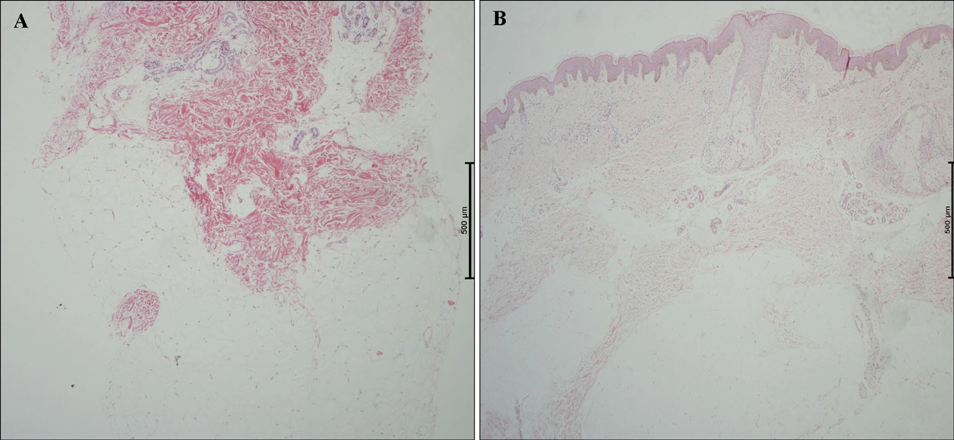Ann Dermatol.
2015 Feb;27(1):87-89. 10.5021/ad.2015.27.1.87.
Congenital Lipedematous Alopecia: Adding to the Differential Diagnosis of Congenital Alopecia
- Affiliations
-
- 1Department of Dermatology, Chungnam National University School of Medicine, Daejeon, Korea. resina20@cnu.ac.kr
- KMID: 2264844
- DOI: http://doi.org/10.5021/ad.2015.27.1.87
Abstract
- Lipedematous alopecia is a rare condition of unknown etiology characterized by a thick boggy scalp with varying degrees of hair loss. It is usually seen in adult African-American females, and a case in a 9-year-old was the youngest patient reported thus far. We report on the appearance of this condition in two children, a 6-year-old child and a 10-year-old child. Each presented with congenital patchy hair loss on the occipital area and the left temple. A boggy hairless scalp with soft swelling was detected in both patients. Histological examination showed increased thickness of the subcutaneous fat tissue with a decrease in hair follicles. These features were consistent with a diagnosis of lipedematous alopecia. We report two cases of congenital lipedematous alopecia, which has not been reported previously. Although congenital, these distinct clinical features should be kept in mind in the diagnosis of alopecic hair loss.
Keyword
MeSH Terms
Figure
Reference
-
1. González-Guerra E, Haro R, Angulo J, Del Carmen Fariña M, Martín L, Requena L. Lipedematous alopecia: an uncommon clinicopathologic variant of nonscarring but permanent alopecia. Int J Dermatol. 2008; 47:605–609.
Article2. Rowan DM, Simpson A, Wong KP. Lipedematous scalp in a child. Pediatr Dermatol. 2006; 23:276–278.
Article3. Moravvej-Farshi H, Mohtasham N. An unusual case of lipedematous alopecia. Arch Iran Med. 2007; 10:532–534.4. Kim JH, Lee EJ, Lew BL, Sim WY. Clinicopathological observation of triangular alopecia. Korean J Dermatol. 2012; 50:1042–1046.5. Yamazaki M, Irisawa R, Tsuboi R. Temporal triangular alopecia and a review of 52 past cases. J Dermatol. 2010; 37:360–362.
Article6. Yaşar S, Mansur AT, Göktay F, Sungurlu F, Vardar Aker F, Ozkara S. Lipedematous scalp and lipedematous alopecia: report of three cases in white adults. J Dermatol. 2007; 34:124–130.
Article7. Yasar S, Gunes P, Serdar ZA, Tosun I. Clinical and pathological features of 31 cases of lipedematous scalp and lipedematous alopecia. Eur J Dermatol. 2011; 21:520–528.
Article8. Yip L, Mason G, Pohl M, Sinclair R. Successful surgical management of lipoedematous alopecia. Australas J Dermatol. 2008; 49:52–54.
Article



